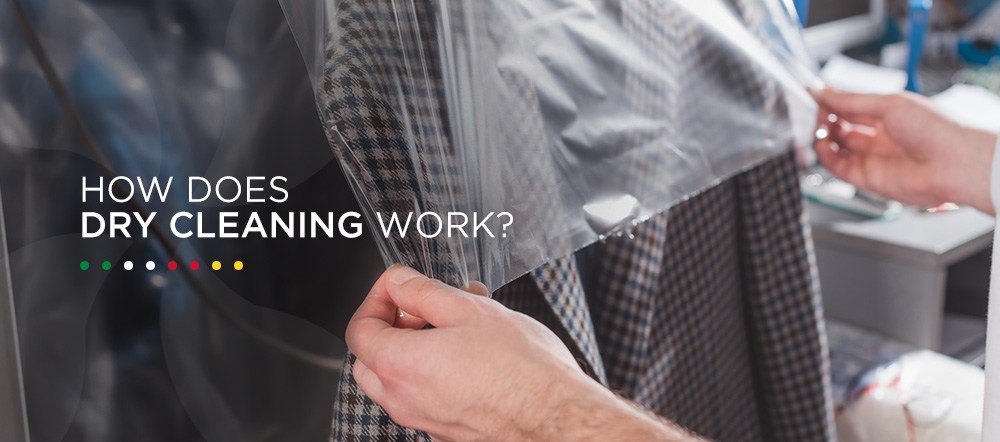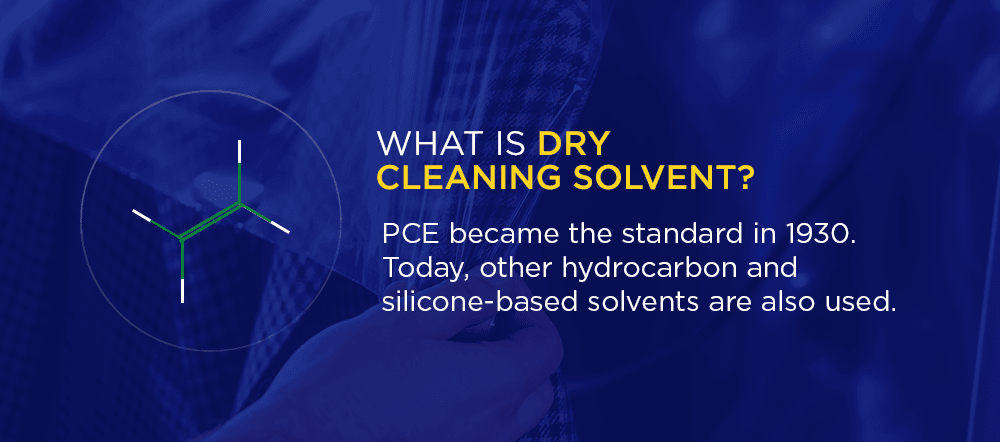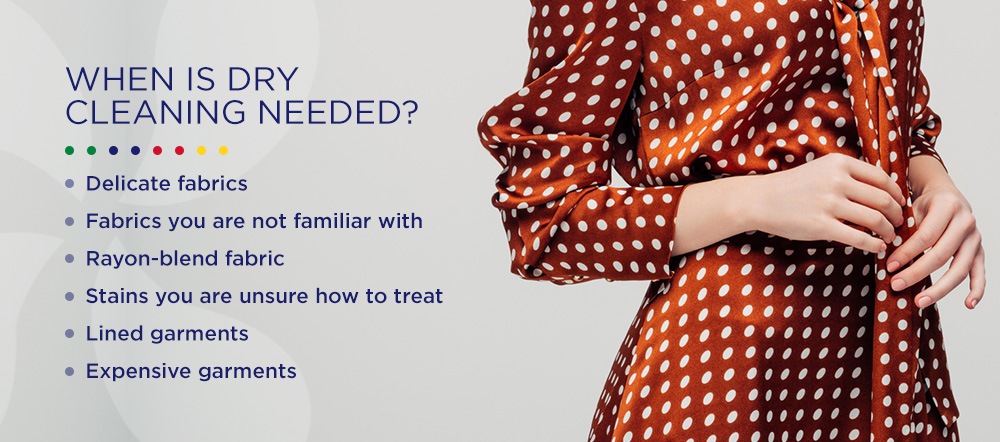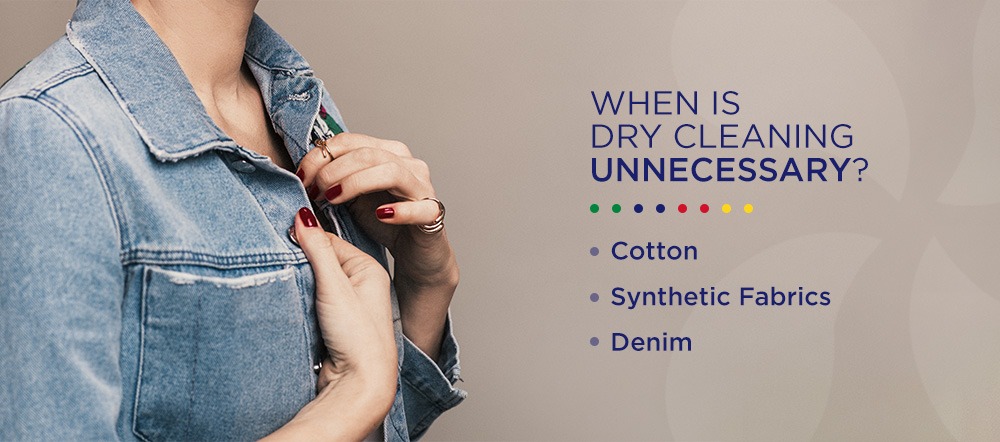
When most of us think about washing our clothes, the first thing that comes to mind is probably water. So how can cleaning clothes be a “dry” process? What does dry cleaning mean? What is the dry cleaning process, and how exactly does it work? Understanding the answers to these questions will highlight the importance of proper fabric and garment care. Professional dry cleaning is a wonderful modern convenience that can help preserve your belongings and save you time, stress and money.
What Is Dry Cleaning?
Despite its name, dry cleaning is actually not a “dry” process at all. A more accurate term would be “water-free” cleaning. Dry cleaners do, in fact, clean fabrics by exposing them to liquids – specifically, liquid solvents such as heated hydrocarbon solvents. They simply don’t use water, as you would in an at-home washing machine. In a professional facility, the dry cleaner will place your fabric item into a dry cleaning machine that is specially designed for a wide variety of items including delicate fabrics.
Once inside the machine, your item is exposed to the liquid solvent, which recirculates through filters throughout the duration of the cleaning process. The solvent is then distilled and completely purified before reuse. Once your item has been cleaned by the liquid solvent, the dry cleaner will remove it from the dry cleaning machine. In the final step of the dry cleaning process, the dry cleaner will typically steam and then press your item. This final step ensures your item is wrinkle-free, stain-free, and ready for your use.
Water-based laundry methods, like washing machines, cause fabric fibers to swell — which may result in shrinkage, color loss, and misshapen clothing. By using liquid solvents rather than water, professional dry cleaners are able to preserve the quality and integrity of delicate fabrics such as silk, velvet, wool, leather, and cashmere, along with many others. In addition, many common fabric stains are caused by grease and oil. Because oil is insoluble in water, these types of stains typically do not respond well to water-based removal processes. Dry cleaning fluids, on the other hand, are much more effective at stain removal.
Dry Cleaning Process: Step by Step
Most professional dry cleaners follow a thoughtful, multi-step process that ensures the utmost care and consideration for your belongings. While the dry cleaning process may vary from cleaner to cleaner, industry standards typically adhere to a process that is comprised of the following steps:
1. Drop Off
You, the garment owner, must first drop off your items at the dry cleaner or take advantage of free pickup and delivery service. If there are specific stains on your clothes that you are aware of, mark them using pins or tape. If possible, compile a list of stains for your dry cleaners. This list will ensure that your items receive care to your satisfaction. Of course, you should always check pockets and empty them before you drop anything off at the cleaners.
2. Inspection
Before they begin the dry cleaning procedure in earnest, dry cleaning employees will inspect each of your items by hand. This way, they will be able to make note of any stains that may need special attention during the dry cleaning process. In addition, the inspection step gives dry cleaning employees a chance to note any flaws, missing buttons, broken zippers, or other pre-existing damages that your items may have.
3. Pre Treatment or Spot Treatment
In the pre-treatment phase, the dry cleaner will apply a stain removal agent or use a steam gun to address any pre-existing stains. These may be stains that you, the garment owner, have identified or stains that the dry cleaner found during the inspection step of the dry cleaning process.
4. Dry Cleaning
Today, most dry cleaners use state-of-the-art, computer-controlled dry cleaning machines. Dry cleaning is a water-free process. Because it does not use water, the dry cleaning process is safe for most delicate fabrics. The dry cleaners will insert your pieces, dry, into their dry cleaning machines. Once inside the machines, your items are exposed to a dry cleaning solvent through a tumble action process. The dry cleaning solvent works by lifting stains and surface dirt away from the fabric. During the cleaning process, the machines cycle the cleaning solvent through filters to ensure it is completely purified and distilled before it is reused.
5. Post Spot Treatment
After the dry cleaning employee takes your items out of the machine, they will inspect your belongings once again for any persistent stains, which they will then work to remove. Post-spotting, as it is commonly referred to, is a relatively simple process, though it does require professional equipment and expertise. During water-based home laundry, wet stains come out during the washing process, while oil-based and grease stains remain. In dry cleaning, the opposite is true — the dry cleaning solvents remove grease stains, and the water-based stains must be removed in the post-spot treatment step.
Professional dry cleaners are skilled at identifying and removing water-based stains during this step while preserving the integrity of the garment. The most stubborn stains are those caused by dyes and tannins — even the most professional, experienced cleaners may not be able to remove those types of stains.
6. Finishing
This is the last step of the dry cleaning process. The dry cleaners will do a final inspection of your items. Typically, they will steam, iron, and press your items to ensure that they are ready for your use. To protect your belongings from the time you leave the cleaners until you return to your home, the cleaners will typically wrap your pieces in plastic garment bags.
It’s important to remove these plastic bags from your items as soon as possible — this step will prevent trapped moisture and undesirable odors from forming.
What Is Dry Cleaning Solvent?
There are a few different types of dry cleaning solvents, or dry cleaning fluids, that are commonly used throughout the professional industry today. The use of solvents dates back to the earliest days of dry cleaning. The first dry cleaning patent belonged to Thomas Jennings, an American tailor and entrepreneur. He earned a patent in 1821 for a process he called “dry scouring,” a precursor to modern-day dry cleaning methods. Unfortunately, the details of Jennings’ patent have been lost to history.
In 1855, a Frenchman named Jean Baptiste Jolly realized that kerosene could be used to clean tablecloths. He opened a fabric cleaning service and called it “dry cleaning.” The use of kerosene and gasoline as solvents was common until 20th-century innovations resulted in safer, more stable options. In the 1930s, a stable, synthetic solvent called perchlorethylene (commonly abbreviated as “perc,” or PCE) emerged as the industry standard. Today, PCE is no longer used by most dry cleaners, being replaced by new dry cleaning methods like heated hydrocarbon and silicone-based solvents.
When Is Dry Cleaning Needed?
Depending on factors like the style of clothing you typically wear, the type of fabrics you wear, your lifestyle, and the climate where you live, the frequency with which you should dry clean your belongings may vary greatly. Luckily, most fabric items are made with built-in tags that include fabric content information and instructions for cleaning and care. While an item’s care instructions tag is always a good place to start, it’s not always easy to ascertain how accurate those care instructions really are.
Because many clothing items represent significant financial investments and are beloved closet staples, you may not want to risk at-home spot treatments or conventional, at-home laundry. The following questions can help you determine what type of care your items need. If you answer “yes” to one or more of these questions, dry cleaning may be the best course of action. You can always consult a dry cleaning professional with any specific questions and concerns that you may have.
-
Is your item made of a delicate fabric such as silk, velvet, suede, leather, wool, or cashmere? Laundering these fabrics at home may result in color loss, pilling, shrinkage, or other problems.
-
Is your item made of a fiber that you are not familiar with or have never cleaned before? You may not want to risk home laundering unfamiliar items.
-
Is your item made of rayon or a rayon-blend fabric? Rayon is hand-washable — however, it is prone to shrinkage when exposed to water.
-
Are there any stains on your item that you are unsure of how to treat? Are there any stains or spots that you know are oil or grease-based? If so, water will not be able to lift them, and dry cleaning is likely your best option.
-
Is your garment lined? If so, are the lining and the outer layers made of the same fabric? Often, garment linings are made of a different fabric than the outer layer. As a result, home washing lined items often results in mismatched and misshapen outer and inner layers.
-
Is the item difficult to iron? Items with many pleats, pintucks, or other tailoring details may never lay the same again after you wash them at home.
-
Does the item hold any special, sentimental value for you? Was it particularly expensive? Imagine if you washed the item at home and it shrunk or became damaged. If you know that would make you upset, it’s definitely worth a trip to the dry cleaners. Better safe than sorry!
If you have a garment that meets any of the descriptions above, you’re in luck — many dry cleaners offer pick-up and drop-off services that make cleaning as simple and convenient as possible.
When Is Dry Cleaning Unnecessary?
Most everyday items do not require dry cleaning or special care instructions. Contrary to what you might think, cotton — perhaps the most common fabric type when it comes to clothing — generally does not need to be dry cleaned. You can easily care for most cotton items at home. Likewise, most synthetic fabrics, such as polyester, nylon, and spandex are durable enough for you to wash at the laundromat or in your washing machine at home.
Cotton
As mentioned, most cotton items are easy to care for. We recommend that you wash cotton pieces in cold water, with similar colors. Today, cotton is generally “pre-shrunk,” meaning that you can tumble dry cotton on a low heat setting. However, if you are especially concerned about shrinkage, simply line dry your cotton items after washing.
Synthetic Fabrics
Most synthetic and synthetic-blend garments can be washed at home. Follow the care instructions on your garments’ tags. If you are unsure of at-home washing instructions, a delicate, cold-water cycle followed by a low-heat tumble dry in the dryer is usually a safe bet.
Denim
Denim is a very durable fabric. It is most often used to make jeans, jackets, and skirts. Because jeans are one of the most popular clothing staples in the world — nearly everyone owns at least one pair — knowing how to care for your denim correctly will save you time and money. If your denim pieces are visibly stained, dirty, or smelly, or if you were sweating while wearing them, you should wash them immediately.
What Items Can’t Be Dry Cleaned?
The dry cleaning process relies on the use of chemical liquid solvents like PCE, and certain fabrics simply can’t hold up to the strength of these processing agents. For example, fabrics that are plastic-based — such as PVC, polyurethane, and neoprene — should never be dry cleaned. Due to the composition of these fabrics, the dry cleaning process may seriously damage these types of items.
Similarly, very fragile fibers like raffia and straw cannot endure the strength of professional cleaning solvents. Instead, spot clean these items with a gentle washcloth. If you have any specific questions about what can and cannot be dry cleaned, consult a professional dry cleaning business that you trust.
Trust Classic Drycleaners for Your Dry Cleaning
The more you learn about the history and practice of dry cleaning, the clearer it becomes that it is a wonderful professional service that you’re lucky to have access to! While we often equate dry cleaning with particular clothing items, it’s important to remember that dry cleaning can be just as effective on most fabric items, such as bed linens, tablecloths, napkins, and many other common home textiles.
Most professional dry cleaners provide many different services to save you time, stress, and money, including wash and fold service, specialized leather care, and professional tailoring, just to name a few. Today, we are all busier than ever — luckily, many cleaners offer pickup and delivery services to make dry cleaning as convenient for your lifestyle as possible.
At Classic Drycleaners, we greatly value your patronage. With eight different locations, we are ready to serve you throughout the Greater Harrisburg region. Consult our full list of services and contact us any time.
Linked:
Tags: dry clean, dry cleaning, dry cleaning solvent, drycleaners





